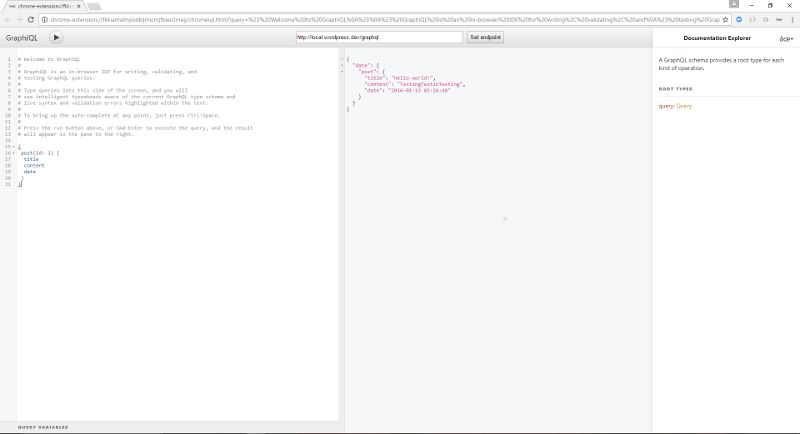Using WP GraphQL
You can send GraphQL requests like you would any old AJAX requests but there is an incredibly awesome tool GraphiQL that has been created by Facebook. If you want to play around in GraphQL there is no better way at the moment. GraphiQL comes highly recommended!
Make sure WP GraphQL is running
Before diving in deeper, make sure that the WP GraphQL endpoint is running properly. The WP GraphQL endpoint will be located at your WordPress's base url followed by /graphql. If your site is running at http://wow.graphql-isawesome.com/ then the WP GraphQL endpoint will live here: http://wow.graphql-isawesome.com/graphql. If everything is running propery you will be greeted by a friendly welcoming message:
{
data: {
hello: "Welcome to WP GraphQL, I hope that you will enjoy this adventure!"
}
}
If you do not see the message make sure the WP GraphQL plugin is activated for your WordPress install. It is also possible that other plugins are conflicting with WP GraphQL. If you use plugins that modify WP Rewrite rules heavily it may be possible that it will somehow break WP GraphQL. In most cases as long as the WP GraphQL plugin is activated and you are running WordPress 4.7+ and PHP 5.4+, then WP GraphQL will work as intended.
GraphiQL
GraphiQL is a tool that makes working with GraphQL incredibly easy. It features the ability to write queries, see the response and to view the schema backing GraphQL. To use GraphiQL in the browser install this chrome extension; ChromieQL.
ChromieQL
After installing ChromieQL, you will want to open it up from the icon in the upper right of Chrome. It should look something like this:

You will want to set the endpoint to match your WP GraphQL endpoint. The endpoint is set in the top banner's center input. The left column is where you will want to put your GraphQL query. The left column also features instructions on how to complete a query.
Towards the upper right will be an expandable menu labeled Docs. The Documentation Explorer displays the available queries and types for WP GraphQL. This is an indispensable tool for understanding WP GraphQL's type system.
ChromieQL is a great debugging tool. I recommend exploring with ChromieQL before you try using WP GraphQL in an application, plugin or theme.
JavaScript Fetch API
To use WP GraphQL in a JavaScript app you can use the Fetch API or good old XMLHTTPRequest. Here is a basic example using the Fetch API. The example below is in es5, for the sake of compatibility, but it looks even better in es6! The example below is very rough, and is only intended as a working demonstration:
// Our endpoint change the address to match your domain.
var graphqlEndpoint = "http://local.graphql.dev/graphql";
// This query fetches the title, content, and author name of post number 1. It is equivalent to below:
/*
{
post(id: 1) {
title,
content,
author {
name
}
}
}
*/
var query = "{post(id:1){title,content,author{name}}}";
// Build query string.
var queryString = "?query=" + query;
// Combine the endpoint with the query string.
var someUrl = graphqlEndpoint + queryString;
// Fetch the url.
fetch(someUrl)
// When the promise resolves return the response as parsed json.
.then( function( response ) {
return response.json();
})
.then( function( response ) {
// Log the data in the console and return it.
console.log( "WooooWEEE that's some nice GraphQL", response.data );
return response.data;
});
Future Client Library
When the server side of WP GraphQL is more developed, featuring proper authentication, security measures, and better infrastructure, a JavaScript client library will be developed to make it quick and easy to use WP GraphQL client side. Relay can be used once WP GraphQL is Relay compliant.